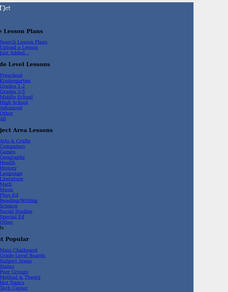Teaching Tolerance
Using Photographs to Teach Social Justice | Exposing Racism
Photographs capture a moment in time. And some of the best pictures demand that viewers not only ask questions about why the photo packs such an emotional wallop, but also about what happened before and after it was taken. A photograph...
Teaching Tolerance
Using Photographs to Teach Social Justice | Confronting Unjust Practices
A powerful photograph of the Freedom Riders of 1961 launches an examination of the de jure and de facto injustices that the civil rights movement of the 1950s and 1960s addressed. Young historians first watch a video and read the Supreme...
Missouri Department of Elementary
The Clique
Mean girls and bully packs are favorite topic for films and TV shows that focus on the destructive power of cliques. High school freshmen are asked to reflect on both the positive and negative aspects of cliques by reading a short...
Digital Public Library of America
Frederick Douglass and Abraham Lincoln
Frederic Douglass and Abraham Lincoln, although dissimilar in their backgrounds, were united in their views about slavery. A set of 14 primary sources permits scholars to examine the views of these two powerful men.
Curated OER
Semantic Gaps and Sources of New Words
The 44 slides in this power point presentation make visual the salient points in a college lecture to develop language and semantic awareness.
Curated OER
Bungee Jump Lab
Student apply linear relationships to the real world. They use Ken and Barbie dolls and experiment to find the line of best fit. They collect data, analyze data, and make predictions from it. The learners also use Microsoft Power Point...
Curated OER
Jay Gatsby's Souvenir Scrapbook
Learners create a Power Point scrapbook that compiles memorabilia representing the life of Jay Gatsby. They read the novel, "The Great Gatsby" and conduct internet research using the "American Twenties" website. In small groups, they...
Curated OER
Marching to Freedom: PowerPoint Presentation debating for or against going to war
Fourth graders present research on war. In this debate lesson, 4th graders create a power point presentation debating for or against the American Revolution. Students share their presentations with the class.
Curated OER
Personal Narrative
As a review of the characteristics of a personal narrative, or as in introduction to this type of writing, this power point presentation could help writers better understand narrative writing. You might want to alter or add information...
Curated OER
Conservation of Energy
The 4-stroke engine is the first example of this Power Point. Other examples include skating and a demolition machine. The potential energy and work involved that is then converted to another form, is presented in slides that are...
Curated OER
Visual Poetry Lets Students 'See' The Words
Pupils read a favorite poem and create a Power Point slide show depicting a visual interpretation of the images in the poem.
Curated OER
Lemonade Business
Twelfth graders use all features of Microsoft Excel and Microsoft Power Point to create charts and graphs. They use charts and graphs to make a Power Point Presentation.
Curated OER
Catholic Schools in the Community
Students are provided with a multimedia Power Point presentation that explains the educational opportunities that are available at the St. Mary Catholic School. They are presented with all facts along with the community as a whole and...
Curated OER
Small Business
Students simulate owning and running a small business by playing Lemonade Stands. They play the game for three weeks, then work with a partner to produce a Power Point presentation which would be given to a Board of Directors showing...
Curated OER
Can Diet and Exercise Help?
Young scholars research information on diabetes. In this health and or language arts lesson, students develop Power Point presentations to demonstrate how life style choices affect the risk of developing diabetes. This is a great...
Curated OER
How Are Polymers Utilized in Everyday Life?
Students investigate polymers and their uses in everyday life. In this polymers lesson, students are assigned one of the 10 areas of polymer science and they do research on their assigned area using the internet. Students gather their...
Curated OER
The Last Great Race
Third graders identify and discover why the Iditarod race is done each year. They explore the historical significance of the Iditarod. Students also use web sites to research related topics, i.e. diseases (diptheria), geography of...
Curated OER
Biology-Genetics
Students predict the probable mode of inheritance from a pedigree diagram showing phenotypes. They study the genetic basis for Mendel's laws of segregation and independent assortment. They give a Power Point slide show demonstrating the...
Curated OER
The Preterite vs. the Imperfect
Students write their own original studenT story in the past in Spanish using the imperfect and the preterite after watching the teacher present the provided Power Point presentation on the differences in the uses of the two.
Curated OER
Mate Selection: Characteristics, Qualities, and Values
Students develop a personal philosophy about marriage while participating in power point presentation, classroom activities, and discussion. They compose a personal list of characteristics, qualities, and values desired in a marriage...
Curated OER
Presenting Powerful Outlines for Science Fair Reports
Middle schoolers examine and reflect on the role of science reports in the larger scientific community and become familiar with one scientist's experience preparing a report. They identify key points to build a strong science report and...
Curated OER
Power Point Presentations
Students explore the Powerpoint program and create slides, transitions, sound, background and graphics.
Japan Society
The Russo-Japanese War, 1904-1905: A Turning Point in Japanese History, World History, and How War is Conveyed to the Public
The big question: How did Russo-Japanese War imagery and the press influence Japanese perception of the war? Learners consider this big question as they compare and contrast various artistic media from the period. The lesson is...
Curated OER
The Power of Graphical Display: How to Use Graphs to Justify a Position, Prove a Point, or Mislead the Viewer
Analyze different types of graphs with learners. They conduct a survey and determine the mean, median and mode. They then identify different techniques for collecting data.
Other popular searches
- Power Point Autobiography
- Power Point Peer Pressure
- Power Points Aztecs
- Characterization Power Point
- Isaac Newton Power Point
- Marine Biology Power Points
- Prehistory Power Point
- Forensic Science Power Point
- Power Point Presentations
- Power Point Lesson Plans
- Power Point Science Safety
- Power Point Fairy Tale

























